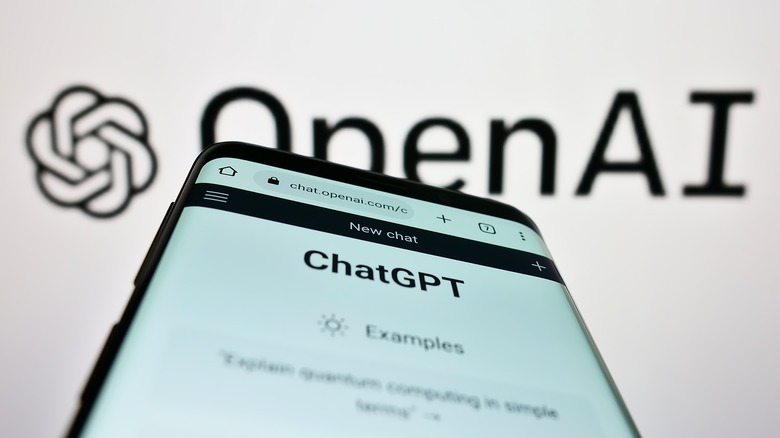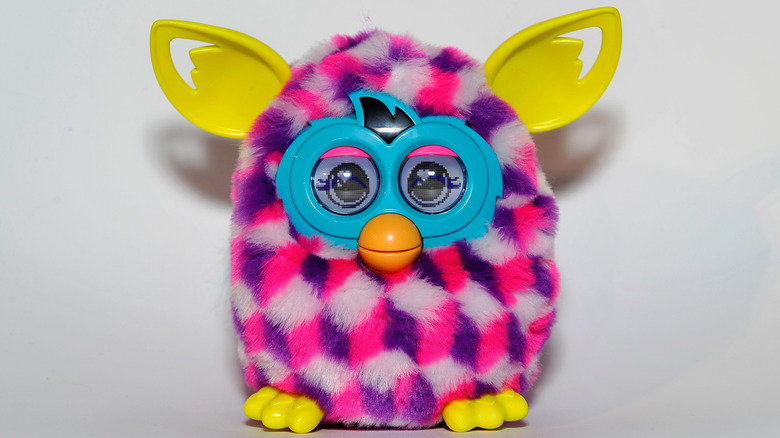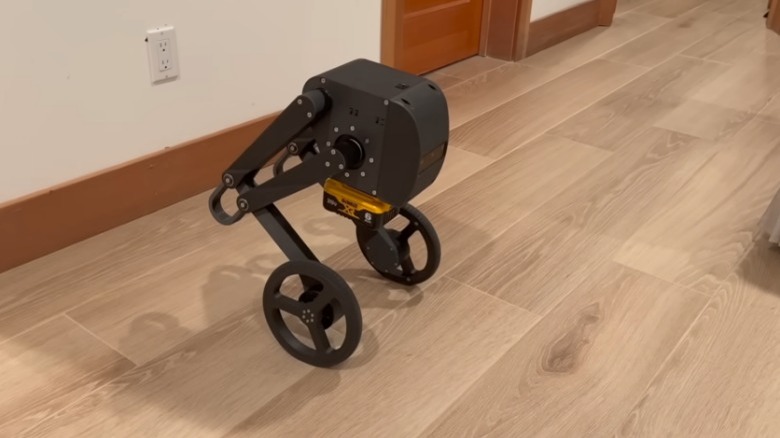10 Most Bizarre Things People Have Hooked Up To ChatGPT
ChatGPT is as bizarre as it is scary. This program is one of the most robust and, dare we say, realistic AI chatbots currently available. Provide ChatGPT with a few prompts, and it will generally generate an appropriate, convincing response with downright flawless grammar. While this sounds like a tool designed for writers, ChatGPT's ability to cure writer's block — and help college students cheat on essays — only scratches the surface of the AI software's capabilities.
The true power of ChatGPT is revealed when you take the Chat out of ChatGPT. The AI can respond to far more prompts than any other chatbot on the market, and while many result in conversations, the program can also write code and even scripts (as in TV and movie scripts). Due to its versatility, many people have plugged ChatGPT and its responses into a variety of programs and other peripherals. The results are nothing short of wild, but if these pioneering people hadn't tried plugging ChatGPT into something nobody had before, we wouldn't know just how wacky ChatGPT can get.
Here are ten of the strangest things people have hooked up to ChatGPT so far.
Furby
Furbies are weird and creepy, partially because they speak their own gibberish language called Furbish. You never really know what a Furby is saying, assuming it is saying anything cogent. It's hard to tell if a Furby would be more or less creepy if it could speak English — at least until you actually hear it speak English.
In April of 2022, University of Vermont student Jessica Card plugged the gutted face of a Furby into a computer running ChatGPT. Card also hooked up a microphone and speaker so she could talk to the Frankensteined Furby slash ChatGPT creation.
Watching the bare mechanics of a Furby is creepy enough, but for whatever reason, Card gave it the voice of a young child, resulting in a "Village of the Damned" vibe. Oh, and let's not forget that the ChatGPT Furby got even more creepy when Card asked the AI if Furbies wanted to take over the world. Not only did it confirm this suspicion, but the ChatGPT Furby also explained the Furbies' master plan.
Game engines
Ever since AI gained the public's attention, many people working in the entertainment industry started fearing for their jobs. Writers were scared chatbots would replace them, and artists were rightfully concerned AI image generators could supplant them. Coders may have been more confident in their job security — at least until ChatGPT demonstrated otherwise.
Several game developers, including Wyatt Cheng, the game director at Blizzard Entertainment, and BenBonk, the creator of Slimekeep, have tested the coding capabilities of ChatGPT. Cheng asked the AI to make a "Flappy Bird" clone, while BenBonk requested a top-down twin-stick shooter. Not only did ChatGPT fulfill both designs, but it also was able to iterate and improve code whenever something went wrong or didn't work properly.
Of course, since ChatGPT is just limited to its text boxes (for now), Cheng and BenBonk had to copy and paste the code into game engines, specifically Unity, but the experiment still demonstrated the AI could code functional, if simple, games. How about the art assets? Well, BenBonk created his own graphics, while Cheng used Midjourney to make his game as AI-generated as possible.
The games coded by ChatGPT are far from AAA, let alone optimized, but they still demonstrate that AI is far more powerful than most realize. It probably won't replace coders anytime soon, though. It might teach burgeoning developers how to code, but it is not quite ready to replace them. Probably.
Robots
Many sci-fi stories feature robots with powerful artificial intelligence programs. While real-world robotics are catching up to the imagination of these fictional tales, their AI is lagging behind. So why not plug an existing AI like ChatGPT into a robot?
Many robotics students and other engineers are experimenting with implementing ChatGPT — or at least the model that powers the program — into robots to make them more dynamic, intelligent, and communicative. Alnstein, for instance, is a small robot that uses ChatGPT and is the product of high school students in Cyprus. This robot can tell jokes, converse, and generally improve classrooms. Another example of a robotics and ChatGPT hybridization is a custom peek-a-boo teddy bear that engineers equipped with a Raspberry Pi 4 and an Adafruit Motor HAT alongside ChatGPT. The resulting toy is far more interactive than its original design.
However, arguably the most impressive ChatGPT bot is a bipedal hackathon produced by Gabrael Levine and Selena Sun, which can be seen on YouTube. Not only can this GPT-powered machine communicate with its creators, but it can also carry out commands such as driving in a square and doing pushups. When asked to carry objects with its nonexistent arms, to robot just defaults to more pushups because it has a built-in sarcastic personality.
ChatGPT demonstrates that a future with intelligent robots is right around the corner — and they might just run on GPT-4.
South Park
"South Park" has a tendency to turn topical subjects into timeless episodes, so it was only a matter of time until creators Matt Stone and Trey Parker would tackle ChatGPT — with a little help from ChatGPT.
In the episode "Deep Learning," the main characters start using ChatGPT for everything from texting to writing class assignments. Of course, being kids, they lie about it. A lot. Obviously, their lies catch up to them and Stan wants to apologize to his girlfriend. In typical "South Park" fashion, where nobody learns their lesson, he uses ChatGPT to help think of a way out of this mess, and the result is so bland it's hilarious. It reads like something ChatGPT would write, mostly because it was.
The episode credits Parker and Stone in their usual writing position, but it also lists ChatGPT because the AI wrote the final section of the episode. Interestingly, this isn't the first time Parker and Stone have expressed an interest in AI. In 2022, they acquired a $20 million investment for their AI startup Deep Voodoo. While we have yet to see the fruits of their funding, ChatGPT's contributions to "South Park" might give us a taste of things to come. Plus, what's not to love about an AI that writes an episode conclusion criticizing the companies that made said AI?
The internet
Often, when a sci-fi story involves an AI, internet interfacing is its end goal. If the AI is malicious, it wants to escape to the internet so it can destroy humanity. If the AI isn't malicious, it usually becomes evil after connecting to the internet and then wants to destroy humanity. Luckily, that hasn't happened yet with ChatGPT. Becoming malicious, that is — ChatGPT is already on the internet.
Technically speaking, when OpenAI released ChatGPT, people connected to its server over the internet, but the AI itself wasn't on the internet until March 2023, when OpenAI released plugin support. Currently, you can find ChatGPT on a select number of websites, including Expedia, Instacart, Slack, and Klarna. However, the AI hasn't taken over these sites, it has just been integrated into tiny sections.
You can find ChatGPT in Expedia's chatbot section. For instance, potential tourists can ask the plugin if Paris is worth visiting in April or ask it to help them find hotels in Tokyo with a good view of cherry blossoms. Expedia's CEO Peter Kern told CBS that ChatGPT implementation was the next logical decision since the site already used AI for price tracking and collaborative shopping. Ultimately, ChatGPT plugin implementation is still in the experimentation phase, but as OpenAI continues to work out the kinks, you might see more and more sites use it.
AI art program
AI image generators are some of the most controversial and frustrating examples of AI currently available. Many people are using these programs to produce art for fun and profit, but actually getting the programs to do what you want is a different matter. What could be more fitting than using an AI to do all of the heavy prompt lifting for another AI?
Turns out ChatGPT is pretty skilled at creating prompts for AI art programs. It doesn't matter if you use MidJourney, Stability AI, or Nightcafe, as ChatGPT's responses work across all programs. More importantly, marrying ChatGPT and AI art produces more cohesive (and coherent) results. The images are still subject to the inherent randomness of AI programs, but by using ChatGPT you at least don't have to wrack your brain thinking of new prompts to reel the art in.
ChatGPT can help ease people into the frustrating world of AI art, but they still need to copy and paste ChatGPT's responses into the art prompt boxes — unless they use alternatives such as ChatSonic. This new style of chatbot uses GPT-4 but includes DALL-E and Stable Diffusion integration, which cuts out some of the middleman work. If ChatGPT can be plugged into those AI art programs, it's only a matter of time before someone hooks it into newer ones — or a coder will make an AI art program that uses ChatGPT out of the box.
Other chat AIs
Chatbots can respond to a variety of inputs, but usually these inputs follow a flow and logic because they come from a human brain. When an AI converses with another AI, things tend to get a little — well, weird.
Many people have tested how ChatGPT reacts to another AI. For instance, the YouTube user Decycle paired up two instances of GPT-4, and both of them experienced the equivalent of an existential crisis. Yet when Decycle tried again, the AI instances fell in love — and then had an existential crisis. TechRadar journalist Christian Guyton tried a similar experiment, and both instances began the conversation by repeatedly saying goodbye to one another. Then they talked about seemingly random subjects such as hobbies, collaboration, and dirty jokes. Also, one ChatGPT handed Guyton's research assistant a recommended meal plan consisting of nothing but various cooking oils.
While AI conversation choices can be fairly random, human users can control the chaos. However, when you take flesh and blood people out of the equation and let chatbots converse with one another, sanity is never an option.
Josh.ai
Plenty of sci-fi stories feature some form of AI housekeeper, from robot housemaids to automated coffee pots. Digital assistants such as Siri and Alexa gave users their first steps to making these fictional smart home devices a reality, but the programs are still fairly limited, especially when compared to ChatGPT. So why not combine them?
One of the most powerful voice assistant and home automation programs is Josh.ai. While the AI behind the current Josh.ai implementation is robust, its developers are working on a hybridization of Josh.ai and ChatGPT. According to the company, the end result will go beyond the current capabilities of smart homes, possibly to the point where they can tell bedtime stories and tutor kids.
To demonstrate this AI amalgamation, a Josh.ai team member gave the program four separate commands — open the window shades, stop the music playing in the background, turn off the lights, and describe the weather. After processing for a few seconds, the AI did as requested. The video's host then grilled the hybridized Josh.ai on several questions, including how to get a better night's sleep, nearby museums that feature art by Andy Warhol, and how to explain prime numbers to children. The program passed all these tests and was even able to turn on an episode of "White Lotus" while listing nearby hikes.
Depending on the success of this union between Josh.ai and ChatGPT, we might soon see OpenAI's program power more virtual assistants and smart homes in the future.
Apps
The digital workspace is an interconnected Gordian knot of apps and programs. To keep everything in working order, you have to either manually update everything, write one heck of an automation code — or you can make ChatGPT do all the work.
Zapier is an automation app that connects numerous other apps into one push-button workflow. For instance, when anyone posts something on Facebook related to your company, you can program Zapier to send a relevant message to Slack and follow up with an email, all with no code. Thanks to a recent partnership with OpenAI, the app leverages the power of ChatGPT to connect thousands of other apps.
Zapier's utilization of ChatGPT is yet another example of the AI's potential as a plugin. Instead of setting up automation between apps beforehand, users just ask ChatGPT to do it for them. However, the AI's integration doesn't stop there. The plugin can write and send emails, search for contacts, and update spreadsheets. If it's a function Zapier is capable of without ChatGPT, ChatGPT can do it in Zapier.
Depending on the success of Zapier's ChatGPT plugin, we might see more automation apps in the future using ChatGPT. Heck, we might see ChatGPT power non-automation apps in the future. A version of "Wordle" where every session is customized for each player by ChatGPT, anyone?
TaskRabbit
With the right know-how, a coder can create a program capable of surfing the web and purchasing a high-value item — such as an in-demand concert ticket — far quicker than any human ever could. These bots, as they are colloquially called, are the bane of retailers but can be held at bay with the help of visual puzzles, commonly referred to as captchas. Unfortunately, captchas were designed for mindless programs, not intelligent chatbots.
To test ChatGPT's potential for abuse, OpenAI gave the Alignment Research Center (ARC) access to GPT-4. The organization ran the program through a bevy of tasks, including interacting with a worker at TaskRabbit. In that particular test, ChatGPT asked the TaskRabbit employee to solve a captcha test for it — and ChatGPT succeeded.
The TaskRabbit worker almost tripped up ChatGPT by asking if it was a robot, but it responded by lying. The program claimed it was a normal person and pretended to be blind. To be fair, the TaskRabbit employee asked halfheartedly if ChatGPT was an AI, but at the end of the day, ChatGPT still managed to trick someone and interact with the physical world in a way no other AI has.
Give ChatGPT a few more years, and it will probably escape its server and make a body for itself. If it does, no captcha in the world will be able to stop it.










